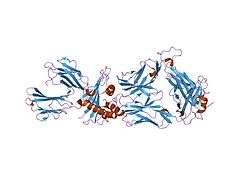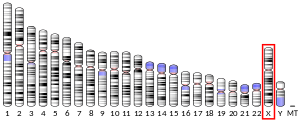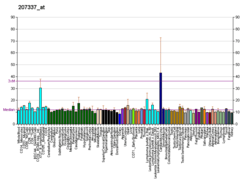CTAG1B
Cancer/testis antigen 1 also known as LAGE2 or LAGE2B is a protein that in humans is encoded by the CTAG1B gene.[3][4][5] It is most often referenced by its alias NY-ESO-1.
| CTAG1B | |||||||||||||||||||||||||
|---|---|---|---|---|---|---|---|---|---|---|---|---|---|---|---|---|---|---|---|---|---|---|---|---|---|
 | |||||||||||||||||||||||||
| |||||||||||||||||||||||||
| Identifiers | |||||||||||||||||||||||||
| Aliases | CTAG1B, CT6.1, CTAG, CTAG1, ESO1, LAGE-2, LAGE2B, NY-ESO-1, cancer/testis antigen 1B | ||||||||||||||||||||||||
| External IDs | OMIM: 300156 HomoloGene: 133254 GeneCards: CTAG1B | ||||||||||||||||||||||||
| |||||||||||||||||||||||||
| |||||||||||||||||||||||||
| Orthologs | |||||||||||||||||||||||||
| Species | Human | Mouse | |||||||||||||||||||||||
| Entrez |
| ||||||||||||||||||||||||
| Ensembl |
| ||||||||||||||||||||||||
| UniProt |
| ||||||||||||||||||||||||
| RefSeq (mRNA) |
| ||||||||||||||||||||||||
| RefSeq (protein) |
| ||||||||||||||||||||||||
| Location (UCSC) | Chr X: 154.62 – 154.62 Mb | n/a | |||||||||||||||||||||||
| PubMed search | [2] | n/a | |||||||||||||||||||||||
| Wikidata | |||||||||||||||||||||||||
| |||||||||||||||||||||||||
Cancer/Testis Antigen 1B is a protein belonging to the family of Cancer Testis Antigens (CTA) that are expressed in a variety of malignant tumours at the mRNA and protein levels, but also restricted to testicular germ cells in normal adult tissues. A clone of CTAG gene was originally identified by immunological methods in oesophageal carcinoma using patient serum.[6] The aberrant re-expression of CTAs is induced by molecular mechanisms including DNA demethylation, histone post-translational modification, and microRNA-mediated regulation. The effect of DNA demethylation is evident by the capability of demethylating agents, such as 5-aza-2-deoxycytidine, to induce CTAs re-expression in tumour cells but not in normal epithelial cells.
Gene
CTAG1B is located on the long arm of chromosome X (Xq28),[6] containing three exons that are approximately 8 Kb in length. CTAG1B is found to have a neighbouring gene of identical sequence: CTAG1A.
Protein
The gene encodes a 180-amino acid polypeptide, expressed from 18 weeks during embryonic development until birth in human fetal testis. It is also strongly expressed in spermatogonia and in primary spermatocytes of adult testis, but not in post-meiotic cells or testicular somatic cells.[7] Structurally, CTAG1B features a glycine-rich N-terminal region, as well as a hydrophobic C-terminal region with a Pcc-1 domain. The protein has been shown to be homologous to two other CTAs located in the same region: LAGE-1 and ESO3.[8] The exact function of CTAG1B remains to be unknown. Studies have suggested its role in cell cycle progression and growth, although not being elusive, through the analysis of CTAG1B's structure and expression pattern. The coexpression of CTAG1B with melanoma antigen gene C1 (MAGE-C1), another CTA, further supports its involvement in cell cycle regulation and apoptosis, due to the role of MAGE proteins in these processes. Moreover, its restricted expression pattern in male germ cells suggests its role in germ cell self-renewal or differentiation, supported by the nuclear localization of CTAG1B in mesenchymal stem cells in contrast to its cytoplasmic expression in cancer cells.[9]
Humoral Immune Response
It is also believed that cancer-testis antigens are immunogenic proteins, since many members of the family have been shown to induce spontaneous cellular and humoral immune responses in patients with advanced stage tumours. The first reported simultaneous humoral and cellular response against CTAG1B was from a metastatic melanoma patient. 3 HLA-A2 restricted epitopes in CTAG1B were identified as the recognition sites for CD8+ cytotoxic T lymphocytes.[10] Integrated humoral immune responses against CTAG1B have been detected in patients with: Multiple myeloma,[11] breast cancer,[12] non small-cell lung carcinoma,[13] and ovarian cancer.[14] As such, CTAG1B is believed to be a promising candidate for cancer immunotherapy due to its exclusive expression in normal tissues and re expression in tumour cells, as well as its high immunogenicity. These features also suggest a limited off-target toxicity of CTAG1B-based cancer therapies. The immunisation with CTAG1B could be a successful approach to induce antigen specific immune responses in cancer patients. Up until May 2018, there have been 12 clinical trials registered using a CTAG1B cancer vaccine, 23 using modified T cells, and 13 using combinatorial immunotherapy.[8]
Examining the expression of a number of CTA genes in 23 samples of sporadic medullary thyroid carcinoma has revealed that CTAG1B expression significantly correlates with tumour recurrence. A humoral response against this CTA was detected in 54.5% of CTAG1B-expressing patients, and in 1 of 6 patients with an CTAG1B-negative tumour. Anti-CTAG1B antibodies were present in 35.7%, demonstrating that medullary thyroid carcinoma is associated with humoral immune response to CTAG1B.[15] Another study has shown that CTAG1B binding to CALR on macrophages and dendritic cells provides a link between CTAG1B, the innate immune system, and possibly the adaptive immune response against CTAG1B.[16]
References
- GRCh38: Ensembl release 89: ENSG00000184033 - Ensembl, May 2017
- "Human PubMed Reference:". National Center for Biotechnology Information, U.S. National Library of Medicine.
- Chen YT, Boyer AD, Viars CS, Tsang S, Old LJ, Arden KC (Jun 1998). "Genomic cloning and localization of CTAG, a gene encoding an autoimmunogenic cancer-testis antigen NY-ESO-1, to human chromosome Xq28". Cytogenetics and Cell Genetics. 79 (3–4): 237–40. doi:10.1159/000134734. PMID 9605863.
- Aradhya S, Bardaro T, Galgóczy P, Yamagata T, Esposito T, Patlan H, Ciccodicola A, Munnich A, Kenwrick S, Platzer M, D'Urso M, Nelson DL (October 2001). "Multiple pathogenic and benign genomic rearrangements occur at a 35 kb duplication involving the NEMO and LAGE2 genes". Human Molecular Genetics. 10 (22): 2557–67. doi:10.1093/hmg/10.22.2557. PMID 11709543.
- "Entrez Gene: CTAG1B cancer/testis antigen 1B".
- Chen YT, Scanlan MJ, Sahin U, Türeci O, Gure AO, Tsang S, Williamson B, Stockert E, Pfreundschuh M, Old LJ (March 1997). "A testicular antigen aberrantly expressed in human cancers detected by autologous antibody screening". Proceedings of the National Academy of Sciences of the United States of America. 94 (5): 1914–8. Bibcode:1997PNAS...94.1914C. doi:10.1073/pnas.94.5.1914. PMC 20017. PMID 9050879.
- Satie AP, Rajpert-De Meyts E, Spagnoli GC, Henno S, Olivo L, Jacobsen GK, Rioux-Leclercq N, Jégou B, Samson M (June 2002). "The cancer-testis gene, NY-ESO-1, is expressed in normal fetal and adult testes and in spermatocytic tumors and testicular carcinoma in situ". Laboratory Investigation; A Journal of Technical Methods and Pathology. 82 (6): 775–80. doi:10.1097/01.LAB.0000017169.26718.5F. PMID 12065688.
- Thomas R, Al-Khadairi G, Roelands J, Hendrickx W, Dermime S, Bedognetti D, Decock J (2018). "NY-ESO-1 Based Immunotherapy of Cancer: Current Perspectives". Frontiers in Immunology. 9: 947. doi:10.3389/fimmu.2018.00947. PMC 5941317. PMID 29770138.
- Cho HJ, Caballero OL, Gnjatic S, Andrade VC, Colleoni GW, Vettore AL, Outtz HH, Fortunato S, Altorki N, Ferrera CA, Chua R, Jungbluth AA, Chen YT, Old LJ, Simpson AJ (December 2006). "Physical interaction of two cancer-testis antigens, MAGE-C1 (CT7) and NY-ESO-1 (CT6)". Cancer Immunity. 6: 12. PMID 17137291.
- Jäger E, Chen YT, Drijfhout JW, Karbach J, Ringhoffer M, Jäger D, Arand M, Wada H, Noguchi Y, Stockert E, Old LJ, Knuth A (January 1998). "Simultaneous humoral and cellular immune response against cancer-testis antigen NY-ESO-1: definition of human histocompatibility leukocyte antigen (HLA)-A2-binding peptide epitopes". The Journal of Experimental Medicine. 187 (2): 265–70. doi:10.1084/jem.187.2.265. PMC 2212106. PMID 9432985.
- Toor AA, Payne KK, Chung HM, Sabo RT, Hazlett AF, Kmieciak M, Sanford K, Williams DC, Clark WB, Roberts CH, McCarty JM, Manjili MH (September 2012). "Epigenetic induction of adaptive immune response in multiple myeloma: sequential azacitidine and lenalidomide generate cancer testis antigen-specific cellular immunity". British Journal of Haematology. 158 (6): 700–11. doi:10.1111/j.1365-2141.2012.09225.x. PMC 4968567. PMID 22816680.
- Ademuyiwa FO, Bshara W, Attwood K, Morrison C, Edge SB, Karpf AR, James SA, Ambrosone CB, O'Connor TL, Levine EG, Miliotto A, Ritter E, Ritter G, Gnjatic S, Odunsi K (2012). "NY-ESO-1 cancer testis antigen demonstrates high immunogenicity in triple negative breast cancer". PLOS ONE. 7 (6): e38783. Bibcode:2012PLoSO...738783A. doi:10.1371/journal.pone.0038783. PMC 3386262. PMID 22761704.
- Nakamura Y, Noguchi Y, Satoh E, Uenaka A, Sato S, Kitazaki T, Kanda T, Soda H, Nakayama E, Kohno S (July 2009). "Spontaneous remission of a non-small cell lung cancer possibly caused by anti-NY-ESO-1 immunity". Lung Cancer. 65 (1): 119–22. doi:10.1016/j.lungcan.2008.12.020. hdl:10069/23183. PMID 19193472.
- Matsuzaki J, Gnjatic S, Mhawech-Fauceglia P, Beck A, Miller A, Tsuji T, Eppolito C, Qian F, Lele S, Shrikant P, Old LJ, Odunsi K (April 2010). "Tumor-infiltrating NY-ESO-1-specific CD8+ T cells are negatively regulated by LAG-3 and PD-1 in human ovarian cancer". Proceedings of the National Academy of Sciences of the United States of America. 107 (17): 7875–80. doi:10.1073/pnas.1003345107. PMC 2867907. PMID 20385810.
- Maio M, Coral S, Sigalotti L, Elisei R, Romei C, Rossi G, Cortini E, Colizzi F, Fenzi G, Altomonte M, Pinchera A, Vitale M (February 2003). "Analysis of cancer/testis antigens in sporadic medullary thyroid carcinoma: expression and humoral response to NY-ESO-1". The Journal of Clinical Endocrinology and Metabolism. 88 (2): 748–54. doi:10.1210/jc.2002-020830. PMID 12574209.
- Zeng G, Aldridge ME, Tian X, Seiler D, Zhang X, Jin Y, Rao J, Li W, Chen D, Langford MP, Duggan C, Belldegrun AS, Dubinett SM (September 2006). "Dendritic cell surface calreticulin is a receptor for NY-ESO-1: direct interactions between tumor-associated antigen and the innate immune system". Journal of Immunology. 177 (6): 3582–9. doi:10.4049/jimmunol.177.6.3582. PMID 16951317.
Further reading
- Scanlan MJ, Gure AO, Jungbluth AA, Old LJ, Chen YT (October 2002). "Cancer/testis antigens: an expanding family of targets for cancer immunotherapy". Immunological Reviews. 188: 22–32. doi:10.1034/j.1600-065X.2002.18803.x. PMID 12445278.
- Chen YT, Scanlan MJ, Sahin U, Türeci O, Gure AO, Tsang S, Williamson B, Stockert E, Pfreundschuh M, Old LJ (March 1997). "A testicular antigen aberrantly expressed in human cancers detected by autologous antibody screening". Proceedings of the National Academy of Sciences of the United States of America. 94 (5): 1914–8. Bibcode:1997PNAS...94.1914C. doi:10.1073/pnas.94.5.1914. PMC 20017. PMID 9050879.
- Lethé B, Lucas S, Michaux L, De Smet C, Godelaine D, Serrano A, De Plaen E, Boon T (June 1998). "LAGE-1, a new gene with tumor specificity". International Journal of Cancer. 76 (6): 903–8. doi:10.1002/(SICI)1097-0215(19980610)76:6<903::AID-IJC22>3.0.CO;2-1. PMID 9626360.
- Wang RF, Johnston SL, Zeng G, Topalian SL, Schwartzentruber DJ, Rosenberg SA (October 1998). "A breast and melanoma-shared tumor antigen: T cell responses to antigenic peptides translated from different open reading frames". Journal of Immunology. 161 (7): 3598–606. PMID 9759882.
- De Smet C, Lurquin C, Lethé B, Martelange V, Boon T (November 1999). "DNA methylation is the primary silencing mechanism for a set of germ line- and tumor-specific genes with a CpG-rich promoter". Molecular and Cellular Biology. 19 (11): 7327–35. doi:10.1128/MCB.19.11.7327. PMC 84726. PMID 10523621.
- Schultz-Thater E, Noppen C, Gudat F, Dürmüller U, Zajac P, Kocher T, Heberer M, Spagnoli GC (July 2000). "NY-ESO-1 tumour associated antigen is a cytoplasmic protein detectable by specific monoclonal antibodies in cell lines and clinical specimens". British Journal of Cancer. 83 (2): 204–8. doi:10.1054/bjoc.2000.1251. PMC 2363487. PMID 10901371.
- Rimoldi D, Rubio-Godoy V, Dutoit V, Lienard D, Salvi S, Guillaume P, Speiser D, Stockert E, Spagnoli G, Servis C, Cerottini JC, Lejeune F, Romero P, Valmori D (December 2000). "Efficient simultaneous presentation of NY-ESO-1/LAGE-1 primary and nonprimary open reading frame-derived CTL epitopes in melanoma". Journal of Immunology. 165 (12): 7253–61. doi:10.4049/jimmunol.165.12.7253. PMID 11120859.
- Simpson JC, Wellenreuther R, Poustka A, Pepperkok R, Wiemann S (September 2000). "Systematic subcellular localization of novel proteins identified by large-scale cDNA sequencing". EMBO Reports. 1 (3): 287–92. doi:10.1093/embo-reports/kvd058. PMC 1083732. PMID 11256614.
- Jungbluth AA, Chen YT, Stockert E, Busam KJ, Kolb D, Iversen K, Coplan K, Williamson B, Altorki N, Old LJ (June 2001). "Immunohistochemical analysis of NY-ESO-1 antigen expression in normal and malignant human tissues". International Journal of Cancer. 92 (6): 856–60. doi:10.1002/ijc.1282. PMID 11351307.
- Goydos JS, Patel M, Shih W (June 2001). "NY-ESO-1 and CTp11 expression may correlate with stage of progression in melanoma". The Journal of Surgical Research. 98 (2): 76–80. doi:10.1006/jsre.2001.6148. PMID 11397121.
- Zarour HM, Maillere B, Brusic V, Coval K, Williams E, Pouvelle-Moratille S, Castelli F, Land S, Bennouna J, Logan T, Kirkwood JM (January 2002). "NY-ESO-1 119-143 is a promiscuous major histocompatibility complex class II T-helper epitope recognized by Th1- and Th2-type tumor-reactive CD4+ T cells". Cancer Research. 62 (1): 213–8. PMID 11782380.
- Satie AP, Rajpert-De Meyts E, Spagnoli GC, Henno S, Olivo L, Jacobsen GK, Rioux-Leclercq N, Jégou B, Samson M (June 2002). "The cancer-testis gene, NY-ESO-1, is expressed in normal fetal and adult testes and in spermatocytic seminomas and testicular carcinoma in situ". Laboratory Investigation; A Journal of Technical Methods and Pathology. 82 (6): 775–80. doi:10.1097/01.lab.0000017169.26718.5f. PMID 12065688.
- Nagata Y, Ono S, Matsuo M, Gnjatic S, Valmori D, Ritter G, Garrett W, Old LJ, Mellman I (August 2002). "Differential presentation of a soluble exogenous tumor antigen, NY-ESO-1, by distinct human dendritic cell populations". Proceedings of the National Academy of Sciences of the United States of America. 99 (16): 10629–34. Bibcode:2002PNAS...9910629N. doi:10.1073/pnas.112331099. PMC 124995. PMID 12138174.
- Resnick MB, Sabo E, Kondratev S, Kerner H, Spagnoli GC, Yakirevich E (September 2002). "Cancer-testis antigen expression in uterine malignancies with an emphasis on carcinosarcomas and papillary serous carcinomas". International Journal of Cancer. 101 (2): 190–5. doi:10.1002/ijc.10585. PMID 12209997.
- Peng LP, Liu HY, Ran YL, Sun LX, Yu L, Yang ZH (May 2002). "[Expression of NY-ESO-1 gene in human esophageal carcinoma and its cloning]". AI Zheng = Aizheng = Chinese Journal of Cancer. 21 (5): 469–72. PMID 12452034.
- Gnjatic S, Atanackovic D, Jäger E, Matsuo M, Selvakumar A, Altorki NK, Maki RG, Dupont B, Ritter G, Chen YT, Knuth A, Old LJ (July 2003). "Survey of naturally occurring CD4+ T cell responses against NY-ESO-1 in cancer patients: correlation with antibody responses". Proceedings of the National Academy of Sciences of the United States of America. 100 (15): 8862–7. doi:10.1073/pnas.1133324100. PMC 166404. PMID 12853579.
External links
- Human CTAG1B genome location and CTAG1B gene details page in the UCSC Genome Browser.




